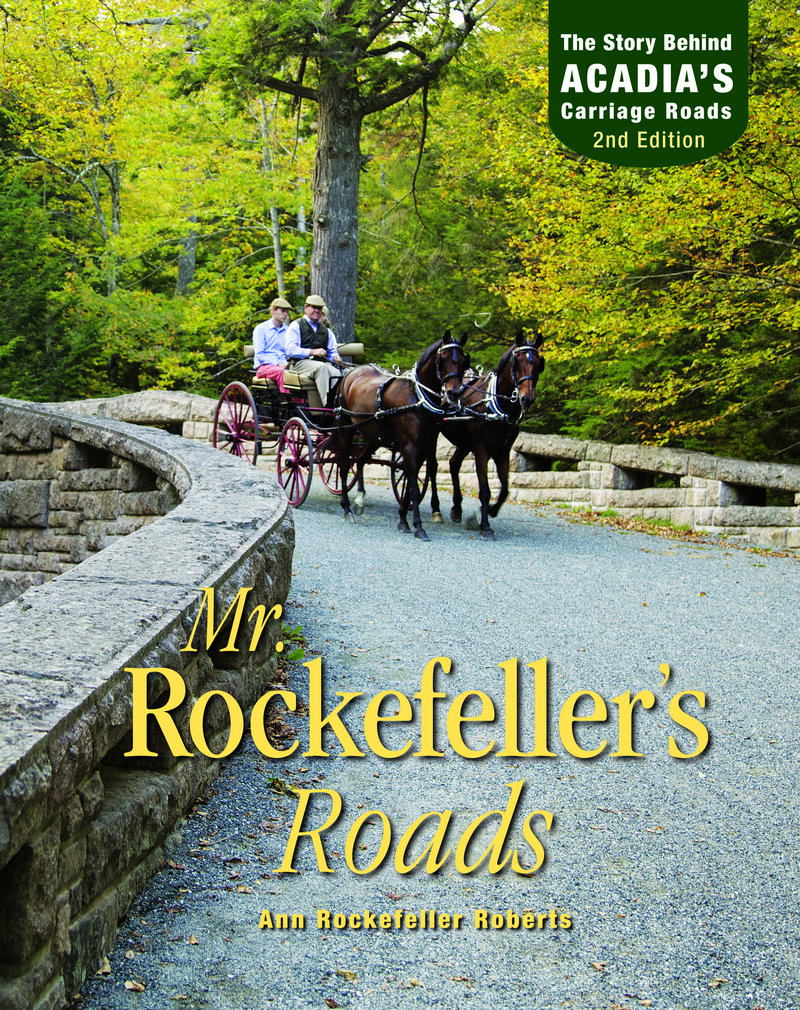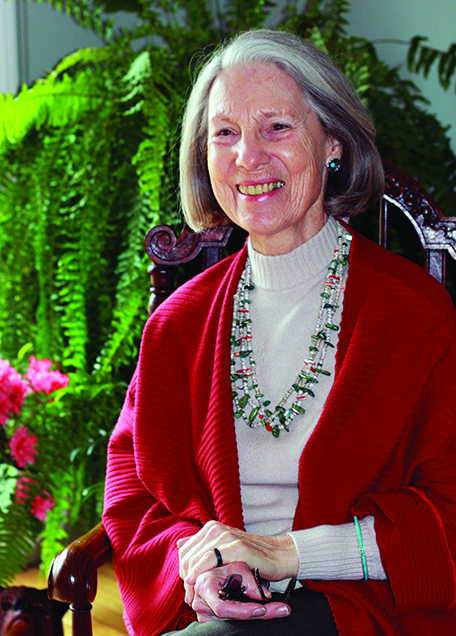John D. Rockefeller Jr. was heir to the Standard Oil fortune. He was shy and retiring, but detail-oriented. When he bought property on Mount Desert Island, home to Acadia National Park, he wanted places to drive his carriages, so he constructed the first of the carriage roads shortly thereafter.
The project lasted 27 years, from the mid-1910s into the 1940s, and Rockefeller — often called JDR Jr. or just Junior — laid out and designed the roads largely by himself, to follow the contours of the land and allow the best possible views.
Ann Rockefeller Roberts, daughter of Vice President Nelson Rockefeller and granddaughter of JDR Jr., wrote a master’s thesis about the roads, then turned that into a book in 1990.
A new edition of that book, “Mr. Rockefeller’s Roads,” was recently published by Down East (256 pages, $19.95). Roberts’ daughter, Mary Louise Pierson, took new photographs and rescanned old ones to make the book much better than the original. Ed Winterberg, a major part of the renovation of the carriage roads who ran the stables for many years, filled in the years from 1990 to the present.
The result is a complete and fascinating history of not only the carriage roads, but to an extent, Acadia National Park.
Roberts recently spoke to us about the new edition.
Q: How did this second edition of the book come about? The original started out as a master’s thesis, didn’t it?
A: It started out as a a master’s thesis, and my adviser said, “You have to publish this,” and I muttered and fussed about not being a writer, and he said, “You just wrote this.”
So I did some more research, and a friend suggested I contact Down East. The first edition was printed in 1990, and it must have been out of print for six or eight years. Down East somehow decided they were interested in doing it again and giving it a new edition, a new format and upgrading the quality of the paper. I organized it all, having the old photographs and papers rescanned in higher definition, and they are just beautiful in this edition.
Q: The photographs by Mary Louise Pierson add a lot to the book. Do her photos replace black-and-white photos from the first book, or are they additions?
A: We used some of those, and did not use some of these. But I agree, my daughter’s photos are great, and add a lot to the book with all those beautiful spreads.
Q: Do you consider the Carriage Roads and JDR Jr.’s role in the creation of Acadia National Park one of his greatest legacies?
A: It was one of the his greatest legacies, something that was very close to his heart. He fell in love with Mount Desert Island and made a home there.
He became part of a group with Charles Eliot, president of Harvard, and George Dorr, who hatched the whole thing. Those three had the foresight and a vision of the park, and the very reason that I was able to write the book was that I found pages and pages of records about it. The telephone was not one of the things that everyone spent half the day on, so he would continue the work by writing when he was away in the winter.
Q: Why did you get Ed Winterberg, who worked on the renovation and ran the stables for many years, to write the update chapter instead of doing it yourself?
A: Because I didn’t have any idea of how it all got done. I got to know him when he was director of Wildwood Stables with his wife, Bobbi, and they did the work with Jack Hauptman. Ed and Jack worked on that chapter together, although Ed did the writing. Before that era, we all knew the park and roads were falling apart. When I was biking and riding the roads, there was a softness to the road, and the drainage was overgrown.
Because of Ed and Jack Hauptman (the roads were restored), and they enlisted the support of David Rockefeller, John D. Jr.’s last living son, who has a house there as well. And then Rick Burke and the Friends of Acadia came along, and the way they came together to restore the roads was amazing. There was no way I could have written about all of that by myself. The two of them lived it, and they had the vision to restore the roads and the whole park, bringing back an awareness and enthusiasm of all the things that are there.
Q: I enjoyed chapter four, “Perseverance amid Controversy,” a lot. The conservation and environmental movements always seem to be split, whether to have people enjoy wilderness and use it or keep people away and leave it wild. Do you think the movements can ever get together?
A: That is a good question, and I dealt with it in the writing of the book. I think there has to be some of both. There have to be some places that need to be wilderness, that should never have roads and should be remote and very difficult to reach.
George Dorr and Junior understood that Acadia National Park was on the Eastern Seaboard Highway and was going to have tremendous pressure, and that the creation of these carriage roads allowed use of the park without destroying it. He wanted regular people to be able to come there and enjoy nature.
I was at a signing, and this woman came up to me and said they come up to Maine so their son, who is handicapped and can’t walk or speak much, can get out in nature. They take him out on the roads every day. So, yes, I think there needs to be some of both.
Q: Living in Maine, I was aware of the carriage roads, but did not know about the role that Beatrix Farrand played in the plantings at the gates and along the roads. Does any of her work survive, or has time and nature taken it in?
A: They did natural planting and only used native species so they would look as though they had never been disturbed, and it is really great that they did that. There is probably not much of her original plantings left, except maybe the large trees that they put in the triangles. And things like the plum trees and blueberries would seed themselves.
But the Abbe Garden here was designed by her, and that remains because the form remains. It is the same with the roads. The roads remain, and the plantings have just evolved and changed with nature.
Q: It must be gratifying that the carriage roads are all in good shape and being used again.
A: The maintenance is very good, the drains have been cleared, and the roads are in better shape than they have been for years. There is a very amazing volunteer program run by the Friends of Acadia, and one of my grandnieces is working on that this summer. They have just raised more than $600,000 for the maintenance of the park. There is such a devoted public here.
Q: Is there anything you’d like to say that we haven’t covered?
A: Just that doing these signings has been just astonishing. There is a diverse public of local people whose families worked on the roads, summer people who have been coming here since they were children and love the story. I have had people come who wanted me to sign the first edition and bought the second edition too.
I have nothing but admiration for the park service and devoted park superintendents and rangers who look after all of these parks, but Acadia is unique. There are no other carriage roads, with people riding carriages on the roads, anywhere else in the park system.
This park happened because of the vision of George Doore and Charles Eliot, and the foresight of John D. Jr. They wanted the park to go from one side of the island to the other, all the way from north to south. They wanted it to be linked, and to be forever in the future.
People sometimes ask me why, in the end, John D. Jr. didn’t endow the park so that we didn’t have to do anything. But he took care of the park as long as he lived, and restored it after the 1947 fire. But when his time was up, he said, “Now, it is yours.” Now it belongs to us, and we are the ones who have to take care of it.
And I want to state my appreciation of the engineers, contractors, stone masons and builders who created the roads. It is a special, amazing thing.
Tom Atwell is a freelance writer living in Cape Elizabeth. He can be contacted at 767-2297 or at:
tomatwell@me.com
Send questions/comments to the editors.




Comments are no longer available on this story